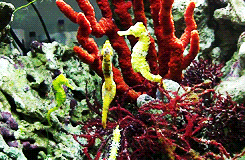Our favourite collective nouns in the marine world
A big thanks to Hannah Hesford for this guest blog post:
Who doesn't love a good collective noun? A murder of crows, a parliament of owls, a skulk of foxes - the list goes on. But did you know that there are a wealth of weird and wonderful collective nouns that are exclusive to ocean-dwelling animals? Here are 10 of our favourites.
A “fever” of stingrays
Stingrays are usually found gliding around the warm, shallow waters of the tropical and subtropical oceans. Although they generally like to swim solo, some larger species – such as the Cownose ray – are known to mingle in huge throngs when breeding or migrating. This epic gathering is known as a “fever” and numbers have been recorded to reach a whopping ten thousand. A ray-diant sight to behold!
A “smack” of jellyfish
A smack can be a painful punishment, often delivering a nasty sting. It’s no surprise then that this word is also used to describe jellyfish en masse. Incredibly, jellyfish are thought to pre-date dinosaurs by millions of years! Made up of around 98% water, they use their tentacles to paralyse and devour any prey that floats their way. Although getting stung is no fun, jellyfish don’t intentionally attack humans and most stings happen in self-defence.
A “party” of rainbowfish
Yes, rainbowfish are as fabulous as they sound. Naitive to Australia and some parts of Indonesia, there are over 50 species of these freshwater fish. These stunning fish are usually found swimming in rivers, streams, swamps and lakes. They may be small, but what they lack in size they make up for in vibrant colours and heaps of energy. Bring on the party!
A “squad” of squid
OK, so technically this one isn’t strictly legit... yet! The official collective noun for squid is actually a “shoal,” but Cephalopod fans around the world have united in a petition to make “squad” a bona fide term. And we’re right behind them! After all, when you’re known for your camouflage ability, ink-cloud defenses and speedy getaways, you need a cool name to boot. The Humboldt squid, in particular, is known to travel in numbers reaching up to 1,200! Now that’s one squad you wouldn’t want to mess with.
A “family” of sardines
Despite their modest size, sardines play a mammoth role in marine ecosystems. They’re the bedrock of the oceanic food chain, feeding bigger creatures like whales, dolphins and sharks. Sardines are all about unity, so it makes sense that they’re known collectively as a “family.” When they’re under threat, they instinctively squash together to form gigantic “bait balls” as a way of averting predators. Well, you know what they say: families stick together!
A “shiver” of sharks
This is one of our favourite collective nouns for marine animals. Although you might have heard sharks described as a “school” or even a “frenzy,” we think “shiver” has a great ring to it. Maybe it refers to the spine-tingling sensation you might experience upon seeing a posse of sharks swimming in your direction? Or could it simply be because our shark friends are generally cold-blooded? Brrr...
A “troop” of dogfish
What comes to mind when you think of a troop? Heavy artillery? Strength in numbers? Under the sea, a “troop” is the collective noun for dogfish. These long, slender creatures belong to the shark family and, although they seem less intimidating than their cousins, they’re known for their aggressive hunting and canine-like persistence (hence the name!). Like a troop of soldiers, they even brandish their own weapons: poisonous dorsal spines.
A “herd” of seahorses
Seahorses are fascinating creatures. Not least because of their horse-like features but also because they are some of the only animals on the planet where the male carries and bears its young. In true equestrian style, when seahorses congregate, they’re known as a herd. But unlike horses, some of their species are at risk of extinction. This is largely due to habitat loss, pollution and demand for their use in traditional medicine. So, seahorse conservation has never been more important.
A “battery” of barracuda
Barracuda are fast-swimming, predatory fish with streamlined, torpedo-shaped bodies and razor sharp teeth. They can be found in the depths of the ocean, as well as in coastal areas and coral reefs. Many barracuda are known as a “battery,” which we think is pretty apt. Although attacks on humans are very rare, this is the kind of battery you don’t want charging your way!
A “glide” of flying fish
Flying fish are known for their unique ability to - you guessed it - fly. Well, technically speaking it’s more of a “leap,” as they don’t have wings so aren’t capable of taking flight. Instead, they use their streamlined bodies to gain momentum and propel themselves out of the water. Spreading their wing-like pectoral fins, they gracefully skim above the surface. Hence, why they’re known as a “glide of flying fish,” or sometimes even a “squadron.”





